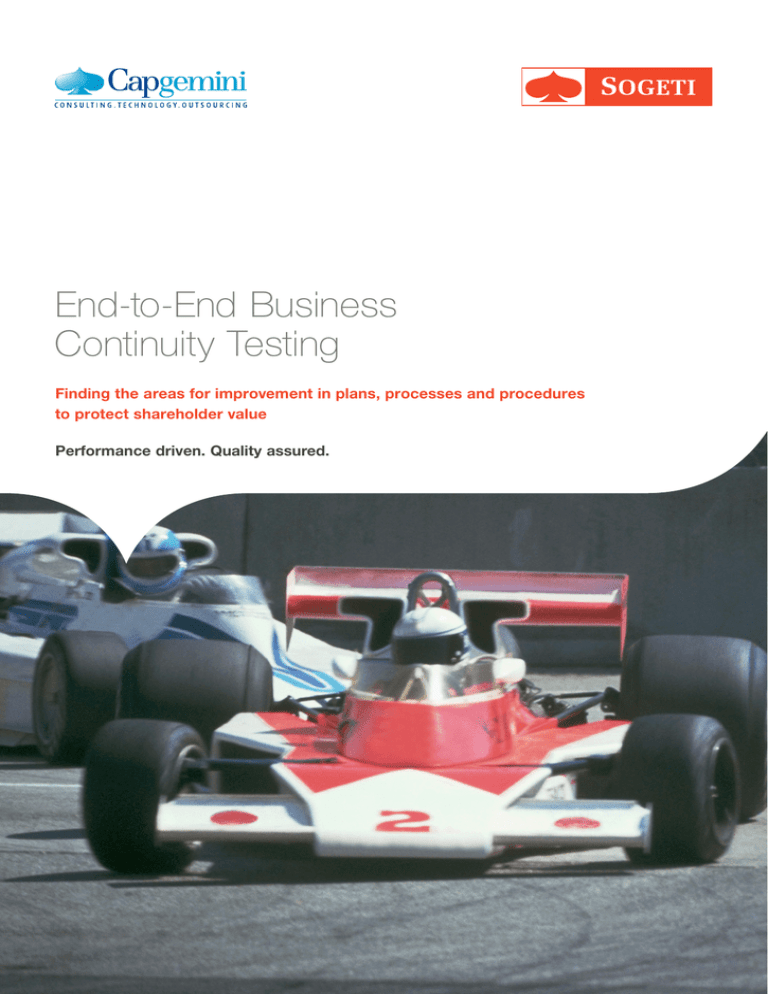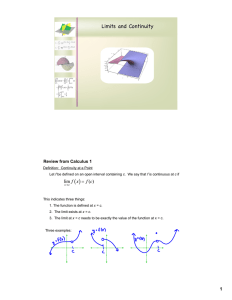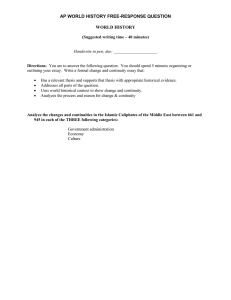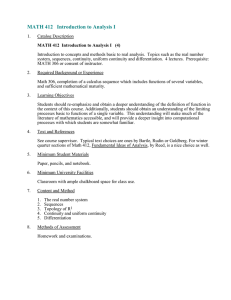
End-to-End Business
Continuity Testing
Finding the areas for improvement in plans, processes and procedures
to protect shareholder value
Performance driven. Quality assured.
End-to-End Business Continuity Testing the way we see it
Introduction
When it comes to Business Continuity Management (BCM), it
is commonly accepted in today’s business world that one
cannot continue to survive with the belief that it’ll never
happen to us. Business Continuity is an integral part of doing
business. Rightly or wrongly, a number of businesses still
believe that business continuity is just an offshoot of risk
management. One definition of BCM is the “holistic process
that identifies potential threats to an organisation and the
impacts to business operations that those threats, if realised,
might cause, and which provides a framework for building
organisational resilience with the capability for an effective
response that safeguards the interests of its key stakeholders,
reputation, brand and value-creating activities1”. A subcomponent is IT Service Continuity Management (ITSCM),
which are the processes related to the recovery and
continuation of technology-based services to support the
business organisation.
With so many aspects of the Continuity regime to address, a
level of document order, hierarchy and integration is essential
to enable the organisation to successfully select and deploy
the appropriate continuity plans from the myriad of plans
available within its arsenal.
Depending on the scale and type of services disruption event
incurred, various plans within the Continuity Management
System will be invoked. Unless the individual continuity plans
include information on how they interoperate and coexist with
the other continuity plans, the implementation of the continuity
work processes may be as disruptive to the business as the
untoward event itself.
BCM and ITSCM utilise risk management practices, but these
are just part of the picture – they also use and apply security,
project, incident and service management principles. It is
planning the processes and activities that the organisation will
need to implement to minimise the impact a disruption will
have on the enterprise - when the disruption occurs.
A holistic continuity management programme addresses all
types of scenarios regarding business disruptions :
• sustained loss of environmental resources at either the
primary worksite or data centre
• fire, smoke, water damage at the worksite
• loss of critical technology services (including: software and/
or hardware problems)
• any event that seriously compromises the security of the
property and/or
• staff at the worksite
• acts of God or natural disasters
• terrorism and/or worksite closures
1 British Standards: BS 25999-2
2
Aspects of Continuity
Management
Since the inception of the continuity planning concept in the
1970s, originally stemming from IT infrastructure disaster
recovery, the Continuity Industry has evolved to cover all
aspects of the business organisation, including:
Technical
Recovery Procedures
s
IT Service Continuity
Including: Disaster Recovery
es
3
ren
2 Standards Australia: HB-221:2004, HB-292:2006
a
Aw
Continuity Management is about planning for the continuation
of business activities during times of unforeseen disruptions to
normal business practices. The efficacy of that planning is
evidenced through the presence of documented processes
and procedures that will be employed throughout the entire
untoward event.
Business
Process Continuity
g&
It is generally accepted throughout the Continuity industry that
each of the plans and/or processes comprise an aspect of the
organisational crisis management structure; in similar fashion
to that outlined in Figure 1.
Alternate
Worksite Plans
nin
The problem is that there is no one standard across all
industries and countries. Each has their own interpretation of
what is right. That said, however, most leading Continuity
industry organisations agree that Business Continuity
Management provides the availability of processes and
resources in order to ensure the continued achievement of
critical objectives2.
i
Tra
The definition, and interpretations, of what Business Continuity
Management actually is varies from organisation to
organisation – as do the supporting objectives
and measurements.
Business Continuity
g,
Originally each of these types of planning had their own
unique definitions of terminology, but with time they have been
used interchangeably and in contrast to their
original meanings.
Crisis
Management
tin
Crisis management
Disaster recovery management
Pandemic planning
Business continuity planning
Contingency planning
Emergency management
Incident management
Disruption management
Business resumption planning
Business resilience
IT service continuity planning
Business process continuity planning.
Tes
•
•
•
•
•
•
•
•
•
•
•
•
Figure 1: Hierarchy of Continuity Plans
The Business Continuity Management plan endeavours to
answer all key critical aspects of keeping the business
operating whilst the event is in progress, including:
• Who: the Crisis Management Command Structure.
• What: which systems and business functions must
continue, either via secondary functions or alternate
workaround processes.
• When: the timing of when to activate different components
and aspects of the subsidiary plans.
• Where: the locations (and/or secondary locations) that will
be used during the disruptive event.
• How: the processes and procedures for how to perform the
critical aspects during the absence of normal business
operations; and the interoperability of the plan types.
Crisis vs. Disaster
Often we find the terms ‘crisis’ and ‘disaster’ being used
interchangeably. However, in practical terms, the two are quite
different. Each term results in a different approach to
escalation and the subsequent response to its resolution.
A crisis is where management is required to deliver a
proportion of their time, attention, energy and resources away
from normal operations to managing an untoward event. If the
crisis escalates and overwhelms management capabilities to
cope, control becomes lost and the event is regarded as a
disaster. It is during the time of disaster that Continuity plans
are invoked and are expected to function as planned.
End-to-End Business Continuity Testing the way we see it
Integration of BCM
and ITSCM
Information Technology systems and services have become a
critical component of most business processes today, often to
the point where many processes are completely unable to
function during any disruption to the technology that they are
reliant upon.
As IT system services are so essential to the operation of
many business processes, it is critical that a holistic end-toend continuity strategy be developed, implemented and
regularly tested, using multiple plans conjointly and
concurrently during the tests.
Impact of an IT Service Disruption
During an IT service disruption, one in which the continuity
plans are activated, unless regularly reviewed and tested, it is
likely that the plans will not be current or contain a sufficient
quantity of gaps in processes and procedures to inhibit their
usefulness when implemented.
It is for this reason that the Business Continuity Plan, the
Business Process Continuity Plans, the IT Service Continuity
(Disaster Recovery) Plans and the Recovery Validation
Procedures need to be clearly documented, integrated and
regularly tested to ensure their currency with today’s
business operations.
A major or catastrophic IT services disruption will require the
activation of one or more ITSC/DR Plans. And, it will mandate
the activation of the Business Process Continuity plans,
aspects of the Business Continuity Plan and potentially the
organisational Crisis Management plan. Continuity documents
need to be effectively and accurately integrated, covering all
aspects of continuity from time of incident, through Plan
activations, data resynchronisation and/or reconstruction, and
the eventual resumption of business processing.
In contrast to the traditional DR approach of planning solely for
the least probable scenario involving a total loss of the data
centre, other resiliency strategies such as high-availability and
active-active implementations, disaster tolerant systems, and
pseudo-real time data replication across multiple sites are
becoming more prevalent in the delivery of IT
Service Continuity.
As each new strategy and solution is implemented, the need
for integrated continuity planning increases – as does regular
testing that the plans continue to maintain their currency with
the solutions deployed.
4
End-to-End Business Continuity Testing the way we see it
Continuity Testing
Many organisations perform annual disaster recovery
exercises, in an attempt to prove their organisation’s (or IT
supplier’s) ability to recover the IT infrastructure and/or
software systems in the event of a catastrophic loss of data
centre. During these exercises, more often than not, the
systems recovered undergo only a cursory level of unit testing
and rarely (if ever) an integrated end-to-end test with the other
continuity plans.
In reality, the most likely plan of the Continuity Management
programme to be implemented is the Business Process
Continuity Plan (BPCP). The BPCP may be activated for any IT
services disruption, whether the ITSC/DR Plan is invoked or
not. It is the responsibility of this plan to outline the activities
the business area will perform throughout the entire event of
an IT service disruption - from time of incident to the
resumption of normal business function.
Enterprise is well prepared to weather any IT services
disruption. Far too often, many ITSC/DR Plans rely on the
assumed knowledge of the implementer and are rarely revised
to maintain currency with changes in technology, system
infrastructure or software upgrades.
Leaving the documentation unchecked and unreviewed
introduces a new, unforseen and often untested risk that
when the time comes to use the documents in a real event
– that they will be incorrect, out of date, or contain too much
assumed knowledge to provide any real assistance in
recovering the system and/or maintaining continuity of
business function.
Further to the BPCP, the ITSCP/DRP needs to clearly
articulate its relationship with the BPCP, and the ITSC/DR
Plans of its upstream, downstream and critically dependent
systems. Integration of the various continuity plans, processes
and procedures (see Figure 2) is an essential factor in
providing evidence to the organisational stakeholders that the
Figure 2: BCM-ITSCM Integration or Interoperability
Crisis
Management
Testing,
Training &
Awareness
Audits,
Tests &
Exercises
Pandemic
Plans
ITSCM
her
BCM
Alternate
Worksite
Plans
C
/ITS
BCM
oget
ork T
MW
High
Availability
Plans
Business
Process
Continuity
Recovery
Validation
Process
Technical
Recovery
Procedures
Disaster
Recovery
Plans
Capgemini Australia ©2011
5
End-to-End Continuity
Intangible Benefits
Testing for integrated End-to-End Continuity is, ideally, a
detailed and systematic review of the organisational continuity
plans, processes and procedures to determine their level of
adherence to, and compliance with, the organisations
pre-established standards and policies, and their alignment
with the industry best practices and international
continuity standards.
• Preservation of market base
• Improved operational resilience to unforeseen
Industry bodies of best practice and standards include: The
Business Continuity Institute (BCI), Disaster Recovery Institute
International (DRII), International Organization for
Standardization (ISO), Office of Government Commerce’s IT
Information Library (ITIL), British Standards Institute (BSI),
Prudential Standard, Standards Australia (SAI Global) and the
US National Institute of Standards and Technology (NIST).
A holistic continuity solution anticipates the entire service
disruption, end-to-end and employs integration and
interoperability of its individual plans. Best practice is to
evaluate the Continuity plans, processes and procedures,
through simulation of one or more major or catastrophic IT
service outage (disaster) scenarios across the entire
disruption lifecycle.
Proving the ability to recover and teaching exercise
participants how to perform business continuity are common
objectives during most Business Continuity or IT Service
Continuity exercises and rehearsals. Testing, on the other
hand, is about finding the areas for improvement in the plans,
processes and procedures.
Improved Quality
End-to-End testing enables the Test Team to identify risks,
weaknesses and gaps within and across the entire breadth of
Continuity plans and strategies, and enables the organisation
to benefit from its Business Continuity programme.
Tangible Benefits
•
•
•
•
•
•
•
•
•
6
Improved protection of shareholder value
Compliance with regulatory requirements
Reduced operational downtime
Lower cost of operation during a disruption
Reduced losses as a result of a disruption
More cost effective recovery / continuity implementation
Improve customer service
Reduce impact of service disruptions
Minimise duration of outages.
disruptive events
• Protection of brand reputation
• Improved efficiency in continuity processes
• Managed exposure to risks associated with
•
•
•
•
business disruption
Provision of competitive advantage
Improved staff confidence
Increased shareholder confidence
Reduction of risk.
Reduction of Risk
The biggest exposure to risk of any organisation is the
implementation of an ‘untested’ plan, or the expectation that
‘untested aspects’ of a partially tested plan will function as well
as the tested components.
Continuity Plan Validation
End-to-End Continuity Testing is about validating the
effectiveness, completeness and accuracy of the Plans,
holistically and integrated across the suite of Continuity Plans.
Its focus is to find as many defects (things that are wrong with
the plans) as possible; enabling them to be rectified and
resolved – improving both the individual Plans and
their integration.
An End-to-End test would span the entire event from time of
incident, its detection, and the escalation to failover; all whilst
executing the appropriate aspects of business continuity.
Figure 3 outlines, at a high-level, some of the plans/processes
that may be enacted during the incident lifecycle. Preliminary
BCP, BPCP and/or ITSCP activities includes standard incident
management processes, where the organisation attempts to
resolve/rectify the incident to prevent an untoward invocation
of a continuity plan.
End-to-End Business Continuity Testing the way we see it
Figure 3: Continuity timeline and plans and processes
Business Continuity Management
Incident Management
Business Process Continuity
Invoke BCP
Time of Incident
Systems Recovered
Invoke BPCP/ITSCP
Detection
& Diagnosis
Resumption of Service
ITSC
Failover/Recovery
Pre BPCP &
ITSCP Activity
Backlog Processing
Data Resynchronisation
Data Reconstruction
Capgemini Australia ©2011
Capgemini Group employs a range of testing strategies to
validate the consistency of the Continuity plans and strategies
including:
If the organisation is exercising the Plan to prove its continued
capability in recovering their systems, then a strict test exit
criteria is recommended; e.g.
•
•
•
•
•
•
•
•
• All planned testing has been completed:
–– 100% of planned test cases executed; or
–– If a planned test case could not be executed, information
Static testing
Functional testing
Non-Functional testing
Point-to-Point (plan to plan) testing
End-to-End scenario testing
Cluster (processes and sub-processes) testing
Black box / White box testing
Audit and Compliance testing.
A Successful Test?
Successful continuity testing is not the same as successfully
executing a continuity or disaster recovery plan. As the goal of
testing is to discover defects in the plan, a successful test is
the test that does not successfully execute all aspects of a
continuity or disaster recovery plan; due to the vast quantity of
defects revealed. In fact: the more defects identified the more
successful the test.
advising the reason and/or justification for non-execution
provided; along with approval by the Continuity Manager
• Nil occurrences of defects which prevent, impede or
severely hinder Continuity
• A maximum of five moderate defects, with remediation
action plans documented
• A maximum of ten minor defects, with remediation action
plans documented.
If 100% of test exit criteria is not, or cannot, be achieved, then
the rehearsal exercise is not successful. Partially achieved is
not achieved.
7
Summary
Modern business has become so reliant upon Information
Technology systems that when IT experiences a services
disruption – so does the business. No longer are computers
seen as an alternate method to reduce processing times of
manual activities. Rather they have become the only method
– the manual processes having been long since
decommissioned. The business is all but unable to return to a
manual process.
Historically the business units accepted, on faith, that their IT
service organisations could recover their critical systems
standard ISO 22301 (Preparedness and Continuity
Management Systems).
Successful rehearsals of one or more individual continuity
plans – in isolation of the other – may provide the organisation
with a cursory level of comfort that, should the unthinkable
occur, their business and IT groups will handle the incident.
But rehearsals do not validate the efficacy of the plans.
Regular audits, walkthroughs and testing of the organisational
continuity plans, processes and procedures – combined with
Figure 4: The Benefits of Integrated Testing
Business Continuity
Business Process
Best Practices
IT Service Continuity
High Availability
an
da
rd s
Disaster Recovery
St
Audi
ts
Walk
thru -
&
Q A ti n g
Tes
– today they require up-to-date and clearly articulated
documentation and plans, that undergo regular exercises to
confirm continuity. Similarly the enterprise is seeking
assurances from its individual business units that they have
adequate and proven capabilities of maintaining business
operations during any service disruption.
Integrated End-to-End Continuity Testing is essential to ensure
a higher degree of consistency with both industry best
practices and international standards, such as ISO 9001:2000
(Quality Management Systems), ISO/IEC 27001:2005
(Information Security Management Systems), ISO/IEC
20000:2005 (IT Service Management) and the forthcoming
HIGHER QUALITY
understanding of best practices and international standards
provide a higher-quality integration continuity solution to the
Enterprise and its business (Figure 4).
Beyond conformance to industry standards and best
practices, an Integrated End- to-End Continuity Test
programme is an indispensable asset toward ensuring that
the organisations’ Continuity Plans will work when needed
most.
About Capgemini and Sogeti
With more than 125,000 people in 44 countries, Capgemini is one of the world’s
foremost providers of consulting, technology and outsourcing services. The
Group reported 2012 global revenues of EUR 10.3 billion. Together with its clients,
Capgemini creates and delivers business and technology solutions that fit needs
and drive the results they want. A deeply multicultural organization, Capgemini has
developed its own way of working, the Collaborative Business Experience™, and
draws on Rightshore®, its worldwide delivery model.
Sogeti is a wholly-owned subsidiary of Cap Gemini S.A., providing local
professional services, specializing in Application Management, Infrastructure
Management and High-Tech Engineering. Sogeti offers cutting-edge solutions
around Testing, Business Intelligence, Mobility, Cloud and Security. Sogeti brings
together more than 20,000 professionals in 15 countries and is present in over
100 locations.
The Capgemini Group has created one of the largest dedicated testing practices
in the world, with over 11,000 test professionals and a further 14,500 application
specialists, notably through a common center of excellence with testing specialists
developed in India.
For more information
about how Sogeti and
Capgemini’s Testing
Services can help
organizations achieve
their testing and QA
goals, please contact your
local Sogeti or
Capgemini account
manager or our Global
Testing Services Team:
Together Capgemini and Sogeti have developed innovative, business-driven
quality assurance (QA) and testing services, combining best-in-breed testing
methodologies (TMap® and TPI®) to help organizations achieve their testing and
QA goals.
Learn more about us at
www.capgemini.com/testing or
www.sogeti.com/testing
©2013 Capgemini Group. All rights reserved. Rightshore ® is a trademark belonging to Capgemini. TMap®, TMap NEXT®,
TPI® and TPI NEXT® are registered trademarks of Sogeti, part of the Capgemini Group. No part of this document may be
modified, deleted or expanded by any process or means without prior written permission from Capgemini.
Mark Buenen
VP, Business Development
Testing Global Service Line
mark.buenen@sogeti.nl
Kevin Quick
Applications Testing Lead
Capgemini US
kevin.quick@capgemini.com




